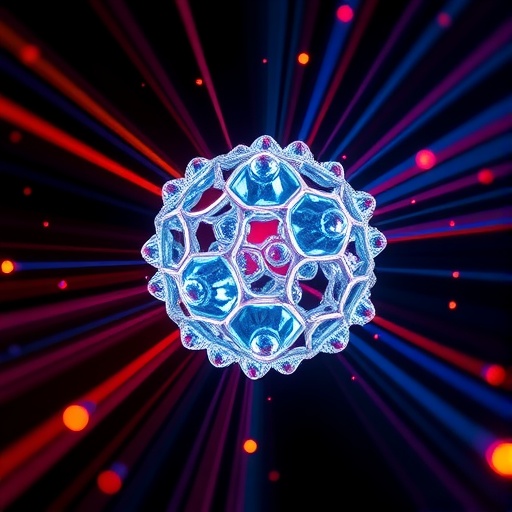In the relentless pursuit of sustainable and clean energy, solar water splitting stands as a beacon of hope, promising to transform sunlight and water into hydrogen fuel—a carbon-neutral energy vector. At the heart of this transformative technology lies the intricate dance of electrons and holes, the fundamental charge carriers generated in a photocatalyst upon absorption of sunlight. However, the ultrafast and atomistic dynamics governing these charge carriers’ behavior have long eluded direct experimental observation, posing a significant barrier to engineering more efficient photocatalysts. A groundbreaking study by researchers Hiroki Uratani and Hiroshi Onishi, recently published in Physical Chemistry Chemical Physics, breaks this barrier by employing quantum-chemical molecular dynamics to unravel the fleeting yet vital process of polaron formation in perovskite NaTaO₃, a material renowned for its water-splitting capabilities.
The researchers adopted a sophisticated computational strategy leveraging Born-Oppenheimer molecular dynamics (BOMD) simulations, enhanced by an accelerated quantum chemical approach known as divide-and-conquer density-functional tight binding (DC-DFTB). This dual methodology enabled unprecedented real-time, atomic-scale visualization of charge carrier stabilization over a sizable model of pristine NaTaO₃ comprising 256 formula units. The simulations tracked atomic motions with femtosecond resolution, capturing the elusive polaron formation process that transpires in less than 100 femtoseconds—far beyond the reach of conventional experiments.
Polarons, localized charge carriers coupled to lattice distortions, play a pivotal role in governing the reactivity and longevity of photoexcited carriers in photocatalysts. Not all polarons are created equal, however. Positive hole polarons and negative electron polarons exhibit starkly contrasting stabilization behaviors in NaTaO₃, as the study reveals. Within merely 50 femtoseconds, hole polarons undergo a rapid and robust stabilization, gaining approximately 70 millielectronvolts (meV) of stabilization energy. This swift process is predominantly driven by the elongation of oxygen-tantalum (O-Ta) bonds—a key structural motif within the perovskite lattice.
This bond elongation acts as a dynamic trap, localizing the positive hole by altering the local electronic environment. Intriguingly, the stabilization occurs in two discernable steps: an initial localization to regions of the lattice where O-Ta bonds are incidentally longer, followed by a further bond elongation facilitated by lattice relaxation. This two-step mechanism elucidates the intricacies of charge carrier stabilization at an unprecedented temporal and spatial resolution. The electron polarons, in contrast, display far less affinity for localization and lack significant stabilization energy changes, their presence spread diffusely over the lattice and subject mainly to stochastic thermal fluctuations.
Such findings shed new light on the fundamental asymmetries between electron and hole dynamics in perovskites, with profound implications for rational photocatalyst design. The stark disparity in polaron behavior suggests that optimizing oxygen-metal bond dynamics—specifically O-Ta—can selectively enhance hole stabilization, thereby extending carrier lifetimes and boosting catalytic efficiency. Consequently, the study advocates for targeted modifications of the B-site cation chemistry within perovskites, tailoring the lattice environment to fine-tune bond flexibility and carrier trapping phenomena.
From a methodological perspective, the innovation lies in coupling electronic structure calculations with detailed atomic motion tracking over large supercells, capturing the inherent lattice disorder and thermal vibrations that significantly impact carrier localization. The study reveals that the polarons are not sharply confined point defects but exhibit weak localization distributed over nanoscale domains. This nuanced understanding challenges simpler theoretical models that overlook lattice fluctuations and highlights the necessity of atomistic resolution to decode the polaron landscape.
The implications of this research extend beyond NaTaO₃ to a wider class of perovskite-based photocatalysts, which are central to solar-to-fuel conversion technologies. By providing a mechanistic framework that connects ultrafast atomic motions with electronic stabilization, the study establishes design principles for engineering heterostructured photocatalysts with finely tuned electron and hole dynamics. The emphasis on controlling bond dynamics opens new avenues for materials scientists to manipulate lattice distortions in pursuit of more robust, efficient, and selective solar fuel production.
Moreover, this comprehensive computational investigation aligns qualitatively with prior experimental observations of trapped carriers on similar time scales, lending credibility and complementarity to ultrafast spectroscopy techniques that infer but do not directly capture atomic displacements. The ability to directly visualize polaron formation at this temporal resolution paves the way for synergistic experimental and theoretical studies, accelerating the translation of fundamental insights into practical innovations.
By focusing on the interplay between charge carriers and local lattice configurations, the research underscores the complex, cooperative nature of photocatalytic activation—far from the static pictures presented in traditional defect theories. This dynamic perspective reframes strategies for catalyst improvement, encouraging the exploration of lattice engineering to optimize energetic landscapes conducive to sustained carrier reactivity.
The meticulous atomistic simulations also highlight the importance of nanoscale disorder and fluctuations, which regulate polaron stability and, consequently, photocatalytic performance on a scale matching experimental observables. Understanding these subtleties is critical for overcoming recombination losses that hamper photocatalytic efficiency, a primary challenge in achieving commercially viable solar hydrogen production.
As green hydrogen emerges as a corner-stone fuel in future carbon-free economies, advances such as this study represent vital stepping stones. By unveiling the ultrafast, structural origins of charge carrier stabilization, the work opens transformative paths for designing next-generation photocatalysts that marry functionality with fundamental materials physics.
In essence, this landmark investigation ushers in a new era of quantum-informed catalyst engineering, where atomic-scale insight directly informs macroscopic energy solutions. It illustrates how cutting-edge computational chemistry can transcend experimental limitations, delivering actionable knowledge pivotal for harnessing sunlight to power a sustainable future.
Subject of Research: Not applicable
Article Title: Quantum-chemical molecular dynamics study of polaron formation in perovskite NaTaO3 as a water-splitting photocatalyst
News Publication Date: 3-Jul-2025
Web References: 10.1039/d5cp01859e
Keywords
Materials science, Photocatalysis, Polarons, Perovskites, Quantum chemistry, Water splitting
Tags: atomistic dynamics in photocatalystscharge carrier stabilizationdensity-functional tight bindingfemtosecond resolution simulationsNaTaO3 photocatalystperovskite materials in energyquantum-chemical molecular dynamicsreal-time atomic-scale visualizationrenewable energy researchsolar water splitting technologysustainable hydrogen fuel productionultrafast polaron formation





